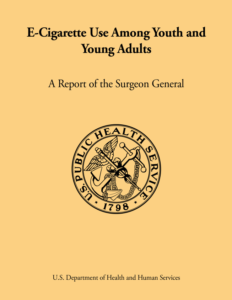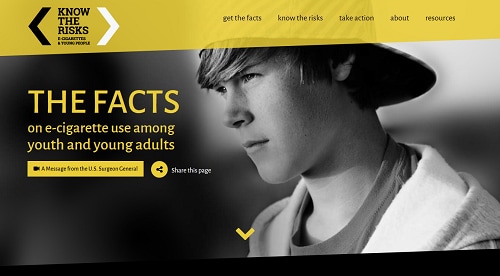 Over 50 years ago, in 1964, the Surgeon General announced with the first Surgeon General’s Report on Smoking and Health that cigarette smoking causes lung cancer and that something should be done to prevent harm. This announcement served as a catalyst for tobacco control and research that has since prevented more than 8 million premature deaths. Today, Surgeon General Vice Admiral Vivek H. Murthy, MD, MBA released the 33rd tobacco-related Surgeon General’s Report on E-Cigarette Use Among Youth and Young Adults, the first federal government review of the public health impact of e-cigarettes.The report focuses on preventing youth and young adult use of e-cigarettes and includes information on the historical background, patterns of use and health effects among youth and young adults, the activities of e-cigarette companies, as well as policy and practice implications.
Over 50 years ago, in 1964, the Surgeon General announced with the first Surgeon General’s Report on Smoking and Health that cigarette smoking causes lung cancer and that something should be done to prevent harm. This announcement served as a catalyst for tobacco control and research that has since prevented more than 8 million premature deaths. Today, Surgeon General Vice Admiral Vivek H. Murthy, MD, MBA released the 33rd tobacco-related Surgeon General’s Report on E-Cigarette Use Among Youth and Young Adults, the first federal government review of the public health impact of e-cigarettes.The report focuses on preventing youth and young adult use of e-cigarettes and includes information on the historical background, patterns of use and health effects among youth and young adults, the activities of e-cigarette companies, as well as policy and practice implications.Highlights from the report:
- E-cigarettes have become the most popular tobacco product among youth, with a quarter of middle and high school students reporting use in the past month, including 1 in 6 high school students. More than one third of young adults (18-24) had tried an e-cigarette by 2014, and 13.6% reported use.
- E-cigarettes have become a $3.5 billion dollar business in the United States, with the industry spending $125 million on advertising e-cigarettes in 2014.
- Nicotine products are not safe for youth. Nicotine can have toxic effects on the developing brain, increasing susceptibility to future addiction and affecting attention, learning, impulse control, and development of mood disorders. It also poses dangers for pregnant women and fetuses.
-

Flavored E-Liquid for Sale Research shows an association between e-cigarette use and use of other tobacco products. Over 58% of high school combustible tobacco users also used e-cigarettes in 2015, and there are five longitudinal studies showing a progression from e-cigarettes to other tobacco products. The Surgeon General also noted during the press conference this morning that more research needs to be done to determine if this relationship is causal.
- Surgeon General notes in the report, “although e-cigarettes generally emit fewer toxicants than combustible tobacco products, we know that aerosol from e-cigarettes is not harmless.” The aerosol that e-cigarettes produce often contains nicotine, ultrafine particles; flavoring chemicals such as diacetyl that have been linked to serious lung disease and other adverse health effects; volatile organic compounds and heavy metals.
- Nicotine-containing e-liquids present a concern for their poisoning potential if ingested. Congress passed the Child Nicotine Poisoning Prevention Act earlier this year to address this threat and require all e-liquid containers to be child-resistant
- Flavors play a large role in youth e-cigarette use with 85% of e-cigarette users age 12-17 using flavored e-cigarettes. Youth and young adults cite flavoring as well as curiosity and low perceived harm compared to other tobacco products as their main reasons for e-cigarette use. At a press conference this morning, a 16-year-old talked about her experience trying e-cigarettes with her friends, saying, “It tasted exactly like a green apple jolly rancher,” but noting that she did not know the products contained nicotine or other toxins.
-
E-Cigarette ads beside other tobacco product ads outside a retailer 70% of middle and high school students reported seeing advertisements for e-cigarettes in 2014, most commonly in the retail setting. The 2012 Surgeon Generals’s Report concluded based on numerous studies that exposure to tobacco marketing causes youth tobacco use initiation. Evidence points to the same relationship between e-cigarette marketing and youth e-cigarette use.
- As for other tobacco products, price affects rates of e-cigarette use. As e-cigarette prices have declined, sales have sharply increased.
- This report calls on the industry to stop advertising and marketing e-cigarettes in ways that appeal and glamorize them to youth and young adults, using the same tactics the tobacco industry has used to market cigarettes.
- The report also notes that there is more to learn about e-cigarettes, including whether e-cigarettes can help adults quit smoking, but that question has not been answered with conclusive scientific data, and the report does not aim to address it. However, the report does conclude that we know enough to act to prevent youth and young adults from using e-cigarettes, and that following the precautionary principle, we should act to intervene.
Call to Action:
The Surgeon General urges action to prevent youth from using e-cigarettes. For state, local, tribal and territorial governments, this includes:
- incorporating e-cigarettes into smokefree policies,
- preventing access to e-cigarettes by youth,
- price and tax policies,
- retail licensure,
- regulation of e-cigarette marketing likely to attract youth, and
- educational initiatives targeting youth and young adults.

Learn more:
- Visit the report’s accompanying website geared to parents and young people.
- Read the full report or the Executive Summary.
- Review this Fact Sheet for public health practitioners
- Review this A Tip Sheet for Parents. A PSA from the Surgeon General tells parents to “know the risks” and emphasizes that “our children are not an experiment.”
- Learn more about e-cigarettes at the point of sale in CounterTobacco.org’s Evidence Summary.


